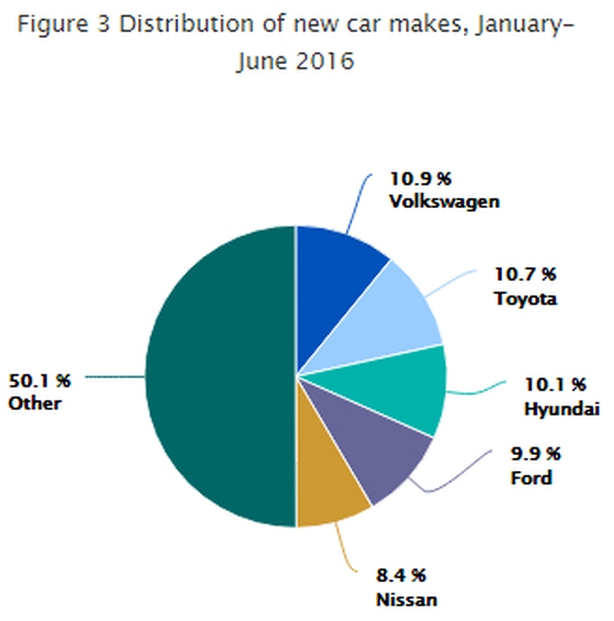As much as 48 charities are directly involved with suicide care in Ireland



IRELAND HAS SOME 48 NON-PROFIT ORGANISATIONS WHICH ARE DIRECTLY INVOLVED IN SOME FORM OF SUICIDE CARE INCLUDING COUNSELLING, PREVENTION AND INFORMATION.
OF THESE, 31 ARE REGISTERED, AND HAVE A REPORTED 153 STAFF.
One of these organisations is Console – which will be closed down shortly following revelations of financial irregularities.
Nearly half the charities are based in Dublin, with significant numbers also in Cork and Kerry.
Financial data was available for 29 of the suicide charities after the filing of accounts with the Companies Registration Office in 2014.
Pieta House had the largest turnover in 2014 with a reported income of €5.4m.
SIX REPORTED AN INCOME OF €500,000 IN 2014.
Public funding for several of the suicide organisations comes from a range of sources including the HSE, the National Lottery, Tusla the child and family agency, county councils and the Department of Children and Youth Affairs.
HSE GRANTS
Other funding was given by the Department of Foreign Affairs and the Department of the Environment.
The HSE’s National Office for Suicide Prevention spent €4.4m in 2014 with the largest grant given to the National Suicide Research Foundation.
It gave €582,998 to the Samaritans, €548,000 to Console and €503,000 to Pieta House.
Shine received a grant of €303,506.
Ivan Cooper, director of advocacy at The Wheel, which supports charities, said: “The charity sector cannot continue to lurch from controversy to controversy – the work of the sector is much too important for that.
“It is the people and communities supported by charities that suffer every time a controversy occurs. We must end this cycle.
“Charities embody an immensely positive social value in Ireland.
“They result from a culture where people take initiatives to address social issues in their communities, and this approach is supported by the public and State entities.
“This vital work must be placed on firm footing, one that provides the necessary transparency and accountability for the public while supporting the trustees, staff and volunteers of charities to do their work.
“In short, we need a coherent policy framework for charities to operate in. We need effective and proportionate reporting for charities.”
Sick leave rates still very high in parts of the Irish public service
REFORMS OF SICK LEAVE ARRANGEMENTS SEE COSTS FALL BY MORE THAN €104M TO €317.9M


DEPARTMENT OF PUBLIC EXPENDITURE AND REFORM SAID THE NUMBER OF DAYS LOST TO SICK LEAVE PER FULL-TIME EQUIVALENT JOBS ACROSS THE PUBLIC SERVICE HAD FALLEN BY 1.0 DAYS TO 8.5 DAYS.
Rates of sick leave in parts of the public service remain high, Minister for Public Expenditure and Reform Paschal Donohoe has said.
However, reforms to sick leave arrangements introduced in 2014 had generated significant savings for the exchequer, he added.
New figures released on Friday by the Department of Public Expenditure showed that, overall, the level of sick leave across the public service has fallen below 4 per cent for the first time.
The figures published by the department revealed that, on average, 10.2 working days per full-time employee were lost in the Civil Service in 2015.
However, the department figures showed that within the Civil Service, areas such as the Irish Prison Service, the Department of Social Protection, theNational Council for Curriculum and Assessment and the Revenue Commissioners all reported higher levels than the average.
A spokeswoman for the Minister said that across the wider public service “areas such as the health sector and the Civil Service have higher average rates of days lost, but management in all areas will be working to further reduce rates of sick leave and absenteeism through the development of targeted strategies”.
SIGNIFICANT SAVINGS
Significant savings have also been achieved through changes. The department said that since reforms to sick leave arrangements were introduced in 2014 – which effectively halved entitlements – the cost to the State had fallen by more than €104 million to €317.9 million.
The department said the number of days lost to sick leave per full-time equivalent jobs across the public service had fallen by 1.0 days to 8.5 days.
The new figures cover about 250,000 full-time equivalent personnel across the public service, including the Civil Service, education, health, justice, local government and defence sectors.
In a statement, Mr Donohoe said: “While there has been a significant improvement since the reform, the rates of sick leave in areas of the public service remain high and need to be reduced further.
“To achieve this, management in each of the sectors must focus on the proactive management of absenteeism, and policies designed to assist employers in managing cases of prolonged or frequent absence proactively will be required.
“This will be a key recommendation in the review of the operation of the sick leave scheme, which is being undertaken by the department.”
He said his department would be establishing a public service sick leave management forum “to provide ongoing support for each of the sectors in managing sick leave in their respective sectors, including the identification of the underlying causes of sick leave and the development of targeted strategies aimed at further reducing sick leave absences.”
He said a target for the rate of sick leave would be set within each of the sectors and this would be monitored on an annual basis.
“It is also intended for the sectors of the public service to publish sick leave absence rates on an organisational/regional basis, where figures are available,” he added.
The number of new cars licensed in Ireland up 23.9% in first half of 2016
VOLKSWAGEN WAS THE MOST POPULAR MAKE OF NEW CAR LICENSED WITH 10.9% MARKET SHARE


VOLKSWAGEN WAS THE MOST POPULAR MAKE OF NEW CAR LICENSED IN THE FIRST HALF OF 2016, WITH 10.9% MARKET SHARE.
The number of new cars licensed for the first time rose by 23.9% in the first six months of the year, figures show.
Data from the Central Statistics Office indicates 97,490 new cars received licenses in the period January to June.
The number of used imported cars rose by 25% compared to the same period last year.
A total of 4,143 new private cars were licensed for the first time last month, an increase of 5.6% compared with June 2015.
A total of 5,459 used cars were licensed, representing an increase of 45% on the same month last year.
Volkswagen was the most popular make of new car licensed in the first half of 2016, with 10.9% market share.
Toyota was the second most popular car make with 10,384 new private cars licensed and a 10.7% market share, followed by Hyundai, Ford and Nissan.
In the first half of 2016, seven out of every ten (70.3%) new private cars licensed were diesel fuelled.
Statins may cut the risk of dying from four common cancers, scientists now believe?



STATINS MAY SIGNIFICANTLY CUT THE RISK OF DYING FROM FOUR OF THE MOST COMMON CANCERS, EVIDENCE SUGGESTS.
Scientists found “striking” reductions in death rate among cancer patients diagnosed with high cholesterol.
Treatment with the cholesterol-lowering drugs taken by millions of people in the UK is the most likely explanation, they believe.
A high cholesterol diagnosis was associated with a 43% lower risk of dying from breast cancer, 47% from prostate cancer, 30% from bowel cancer and 22% from lung cancer.
The findings support previous research indicating that statins may offer protection to cancer patients.
A study published last month in the journal Breast Cancer Research showed that breast cancers can manufacture a tumour-boosting molecule from cholesterol.
Dr Paul Carter, from Aston University in Birmingham, UK, who presented the new findings at a meeting of heart experts in Florence, Italy, said: “Our research suggests that there’s something about having a high cholesterol diagnosis that improves survival and the extent to which it did that was quite striking in the four cancers studied.
“Based on previous research we think there’s a very strong possibility that statins are producing this effect.”
He added: “These findings are likely to be seen in other cancers as well but this is only speculation and would need to be confirmed by studies in different types of cancer.”
The scientists analysed the health records of almost a million cancer patients admitted to UK hospitals over a 14-year period between January 2000 and March 2013.
Clinical information was compared with mortality data obtained from the Office for National Statistics.
OUT OF A TOTAL OF 929,552 PATIENTS, 7,997 HAD LUNG CANCER, 5,481 BREAST CANCER, 4,629 PROSTATE CANCER, AND 4,570 BOWEL CANCER.
After adjusting for factors which might influence life span, including age, gender, ethnicity, and the ten most common causes of death, the scientists found that patients were less likely to die if they had a diagnosis of high cholesterol as well as cancer.
The new research was presented at the European Society of Cardiology’s Frontiers in CardioVascular Biology meeting in Florence.
Curiosity finds unique ripples in Mars Planet dunes



THOUGH BOTH MARS AND EARTH POSSESS WIND-BLOWN SAND DUNES WITH VERY SIMILAR CHARACTERISTICS, IT SEEMS MARTIAN DUNES HAVE A LITTLE SOMETHING EXTRA.
Mars is a planet shaped by aeolian — or “wind-driven” — processes. So it probably doesn’t come as a surprise to know the Red Planet also sports some pretty big sand dunes.
From afar, these dunes strongly resemble the dunes we have on our planet. But in a new study carried out by NASA’s Mars rover Curiosity, an active dune field on Mars has revealed that, though many of the processes that shape Martian dunes are the same processes that shape terrestrial dunes, there’s an extra ripple that can only form in Mars’ atmosphere.
“Earth and Mars both have big sand dunes and small sand ripples, but on Mars, there’s something in between that we don’t have on Earth,” said graduate student Mathieu Lapotre, of Caltech in Pasadena, Calif., in a NASA statement.
On both Earth and Mars dunes can be as large as a football field and consist of a gently-sloping upwind face and a steep downwind face that is shaped by continuous sand avalanches as the prevailing wind keeps pushing material over the apex of the dune. Classical arc-shaped barchan dunes can often result on both planets and Mars satellites have captured some stunning observations of these types of dunes from orbit. Just look at them, they’re amazing.
On Earth, the surfaces of these dunes are often rippled with peaks and troughs spaced around 30 centimeters (12 inches) apart. These rows of ripples are created by wind-carried grains of sand colliding with stationary grains, eventually creating a corrugated texture on dunes covering sandy deserts and beaches.
Until Curiosity started its approach to the active dark Bagnold Dunes six months ago on the northwestern slopes of Mount Sharp, scientists didn’t know whether these small-scale “impact ripples” existed. From orbit, larger ripples measuring around three meters (10 feet)from peak to peak could be seen and it was generally assumed that these larger-scale ripples were equivalent to Earth’s impact ripples, only much larger owing to the thin Martian atmosphere and lower gravity.
But when Curiosity arrived at Bagnold, the rover didn’t only see the 10 feet-wide ripples, but it also saw the small-scale ripples just like Earth’s impact ripples.
“As Curiosity was approaching the Bagnold Dunes, we started seeing that the crest lines of the meter-scale ripples are sinuous,” said Lapotre, who’s also science team collaborator for the Curiosity mission. “That is not like impact ripples, but it is just like sand ripples that form under moving water on Earth. And we saw that superimposed on the surfaces of these larger ripples were ripples the same size and shape as impact ripples on Earth.”
So it turns out that Mars dunes have an added complexity that could only be proven by rolling up close and taking photos. Mars dunes have the small impact ripples, plus medium-sized “sinuous ripples” that can be resolved from space.
Interestingly, though Earth’s dunes don’t possess sinuous ripples, they can form underwater — on a riverbed, for example. Rather than particles colliding, these sinuous ripples are created as flowing water drags particles, causing them to settle in a rippled pattern.
Lapotre, who is lead author of a study that was published on July 1 in the journal Science, thinks that the Martian sinuous ripples are being driven in a similar way, but it’s the Red Planet’s thin atmosphere that’s dragging the particles to form the medium-sized ripples on the sand dunes. Lapotre’s team have nicknamed them “wind-drag ripples.”
“The size of these ripples is related to the density of the fluid moving the grains, and that fluid is the Martian atmosphere,” he said. “We think Mars had a thicker atmosphere in the past that might have formed smaller wind-drag ripples or even have prevented their formation altogether. Thus, the size of preserved wind-drag ripples, where found in Martian sandstones, may have recorded the thinning of the atmosphere.”
But after studying observations (carried out by Curiosity and NASA’s veteran rover Opportunity) of Mars’ sandstone dating back to 3 billion years ago, the researchers found evidence of these wind-drag ripples preserved in the material of the approximate same size as the ripples that exist in today’s Martian dunes. This means the planet lost most of its atmosphere early in its geological history and for the past 3 billion years the atmospheric pressure has remained fairly constant — a finding that fits with other Mars atmosphere evolution models.
“During our visit to the active Bagnold Dunes, you might almost forget you’re on Mars, given how similar the sand behaves in spite of the different gravity and atmosphere. But these mid-sized ripples are a reminder that those differences can surprise us,” said Curiosity Project Scientist Ashwin Vasavada, of NASA’s Jet Propulsion Laboratory in Pasadena.
It’s pretty amazing to think that a fairly simple observation of an active sand dune on Mars can reveal so much about Mars’ current and ancient atmospheric conditions. But as the sophisticated wheeled robot continues its quest to seek out past and present habitable environments, and this is all in a day’s work.
Mars plays host to a huge number of dune fields — regions where fine wind-blown material gets deposited to form arguably some of the most beautiful dunes that can be found on any planetary body in the solar system. Using the powerful High-Resolution Imaging Science Experiment (HiRISE) camera on board NASA’s Mars Reconnaissance Orbiter, planetary scientists have an orbital view on these features that aid our understanding of aeolian (wind-formed) processes and Martian geology. Here are some of our favorite Mars dunes as seen by HiRISE. Pictured here are shell-like “barchan dunes” in the ancient Noachis Terra region of Mars.
Dunes of many shapes, sizes and formation processes can be found on the Red Planet. Shown here are elegant “linear dunes” with deposits of larger rocks and possibly ices in their troughs.
These slug-like dark dunes are striking examples of “dome dunes” — elliptical accumulations of fine material with no-slip surfaces. These domes contrast greatly with the often jagged appearance of barchan dunes. Found at the bottom of Proctor Crater, they are darker than the surrounding crater floor as they are composed of dark basaltic sand that was transported by the wind.
Looking like a wind-blown silk sheet, this field of “star dunes” overlays a plain of small ripples, another aeolian feature. The ripples move more slowly across the bottom of Proctor Crater, so the large dune field will travel over the smaller ripples. Dunes are continuously evolving and moving with the wind, ensuring that the Martian surface is never static.
These “transverse dunes” are undergoing seasonal changes. Likely entering Mars summer, this region of dunes is stained with pockets of subliming ices — likely carbon dioxide. As the ices turn from solid to vapor, dune material slumps, revealing dark, sandy material underneath.
Resembling the mouths of a shoal of feeding fish, this is a group of barchan dunes in Mars’ North Polar region. Barchan dunes betray the prevailing wind direction. In this case, the prevailing wind is traveling from bottom right to top left; the steep slope of material (plus dune “horns”) point to the downwind direction. The HiRISE camera monitors barchans to see if they move between observing opportunities, thereby revealing their speed of motion across the Martian plains.
This is the same barchan dune field, zoomed out, a “swarm” of dunes covering the plains.
Not all barchan dunes “behave” and form neat “horny” shapes. They can become muddled and overlapping, creating “barchanoid dunes,” as shown here.
This very fluid-looking collection of barchans is accompanied by a wind-blown ridge in the Hellespontus region of Mars but…
…only when zoomed out does the true nature of this fascinating region become clear. The prevailing wind is eroding the mesas (small hills) to the right of the image, carrying fine material downwind (from right to left), creating a startling pattern of barchans and a viscous-looking trail of sandy ridges across the plains.
The band Train sang about the “Drops of Jupiter” — what about the “Drops of Mars”? Sure, they’re not made of any kind of fluid, but they do make for incredibly-shaped dunes. These raindrop-shaped dunes are found in Copernicus Crater and are known to be rich in the mineral olivine, a mineral that formed during the wet history of Mars’ evolution.
These craggy-looking dunes are old barchanoids eroding away through seasonal processes (sublimation of sub-surface ices) and the persistent Martian wind.
These linking barchan dunes are at the leading edge of a dune field — grains of dust have been blown across a plain, deposited and left to accumulate in elongated arrow shapes.
Dome-shaped dunes and barchans seem to “reach out” and touch their downwind partners with slumped material.
Barchan dunes inside Arkhangelsky Crater in the southern hemisphere of Mars reveal a wind direction from top left to bottom right. Note the tracks of Martian dust devils over the dune slopes.
No comments:
Post a Comment